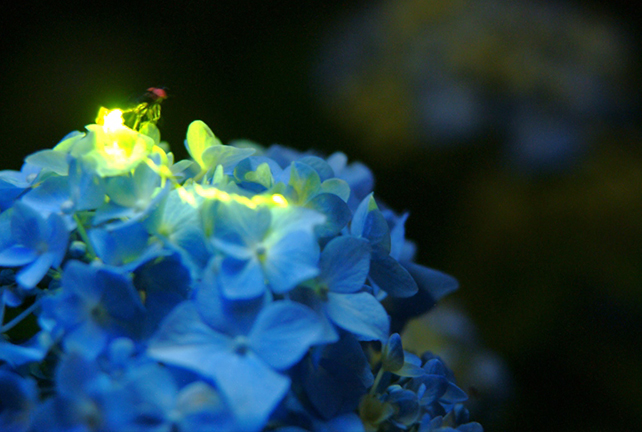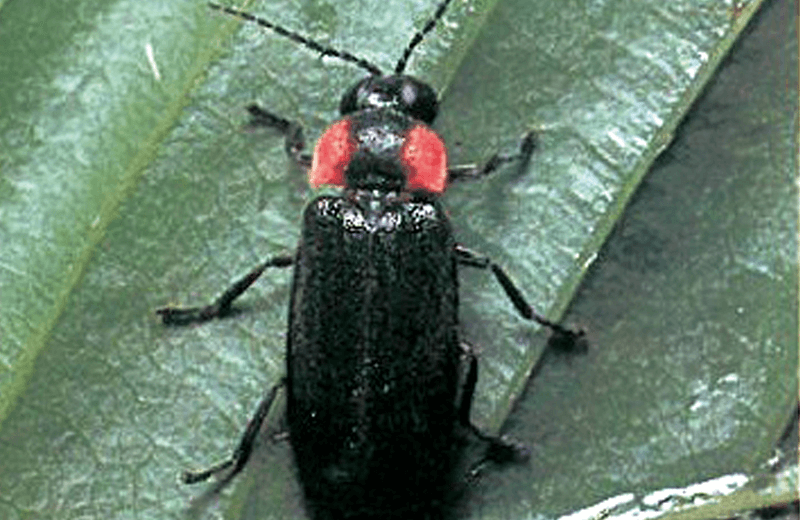History of Preserving Fireflies
History of
Preserving Fireflies
HFirefly temple【Denpukuji】
Up until 1890, the whole area of the Tenryugawa River basin
from the upper Kawagishi (Okaya city) to the lower Kojinyama is
known to be a famous place for beautiful fireflies. Masses of fireflies could
be seen flying and dancing anywhere around this area.
Since there were quite a lot of fireflies,
a bridge once called Ayuzawa-bashi near Kawagishi-station changed
its name into Kankeibashi(Bridge for Watching Fireflies)
at the time of rebuilding in 1879.
In 1910, the river began to be polluted due to the development of
silk-reeling factories and most of the fireflies changed their habitats
downstream, which was the area around Kamihiraide.
In those days, Shimotatsuno was bustling because the railway had opened,
and the town was so crowded with a lot of visitors to see fireflies.
By the middle of the Taisho period, however,
the number of fireflies had decreased rapidly because the local residents
and the visitors could catch as many fireflies as they wanted.
Some people even tried to catch the fireflies with the aim of selling them.

Designated as a Prefectural Nature Treasure Thanks
to Mr. Oguchi
In 1918, Mr. Uzuhiko Oguchi newly arrived at Asahi Higher Primary School
(the present Higashi Elementary School).
Considering that the fireflies would go extinct in that way,
he appealed to the public for the protection of the fireflies by making a booklet titled “A Story on Fireflies” and distributing it among the houses through the children.
Moreover, Mr. Oguchi asked each family in Tatsuno to stop using Hotarukago( a cage used to keep scores of fireflies for viewing) through his students and he walked along the river with his students every night, trying to stop people from catching the fireflies.
With the help of Hiraide youth association, Tatsuno youth association, and Inatomi Higher Primary School (the present Nishi Elementary School), an attempt to preserve fireflies had developed into a large-scale campaign for the whole community. In 1925, the area was designated as a prefectural nature treasure.
(The designated area was expanded in 1928. )The Threat of Extinction
after the Second World WarIn 1948, “Firefly Festival” was brought back in Japan’s postwar economic recovery and the festival started to be held on a large scale once again with the establishment of “Tatsuno-Ondo” and “Hotaru-Kouta”
by the society of commerce and industry in 1949.
However, the nature had been badly damaged and the number of fireflies had far more decreased than the one before the war.
The people involved therefore decided to ask the biology club at Tatsuno High School (under the guidance of Mr. Shigemi Katsuno) to research on the fireflies in 1955.
In February, 1960, the whole area of Matsuokyo Valley in Shimotatsuno was designated as a prefectural nature treasure to be “the source of the fireflies in Tatsuno”, according to the new ordinance for the protection of cultural properties. But the fireflies wouldn’t breed in the main stream of Tenryugawa River at that time.
They were also distributed unevenly in the waterways. A major cause of these phenomena was the water pollution.
In 1961, the biology club at Tatsuno High School started to release firefly larvae into the waterways near Matsuokyo Valley.
Unfortunately, the number of fireflies wouldn’t increase due to the proceeding water pollution, and the fireflies decreased rapidly. The fireflies in Tatsuno were faced with the threat of extinction.Starting the First Artificial
Breeding of Fireflies in JapanTo improve the water quality, uncontaminated fresh water from Osawa was added to the waterways of the upper weir (Denbe-seki). As a result, the number of fireflies stopped decreasing in the area around Matsuokyo Valley, and the number started to be on the increase.
In 1973, at the suggestion of Mr. Katsuno, the Japan’s first pond for artificial breeding of fireflies had made and firefly larvae and their food, thiaridal snails began to be bred artificially.
Since then, people of Tatsuno have continued weeding and dredging up of mud around the waterways. In 1975, a massive amount of fireflies could be seen at last.Continuous Steady Efforts to Preserve Fireflies
The pond for artificial breeding of fireflies was forced to be moved because of the embankment work of Tenryugawa River. Inevitably, they decided to make the present first breeding pond.
After that, such construction works as repairing the waterways of the Matsuokyo Valley upper weir (Denbe-seki) in 1979, creation of the second breeding pond in 1984,
and repairing the big weir in 1987 were carried out.
Thanks to the steady efforts of the people involved including Mr. Katsuno,
wild dancing fireflies can now be seen every year.
Also, Firefly Children’s Songs Park in Kamihiraide was completed.
Steady efforts to preserve fireflies have been continuing and expanding even today.


















































